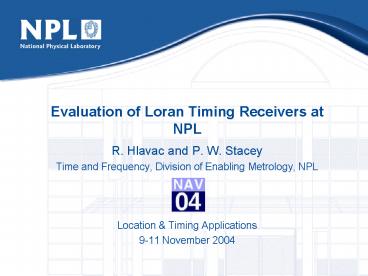Evaluation of Loran Timing Receivers at NPL - PowerPoint PPT Presentation
1 / 20
Title:
Evaluation of Loran Timing Receivers at NPL
Description:
Time and Frequency, Division of Enabling Metrology, NPL. Location ... Derived from a single hydrogen maser. Kept within 30ns from UTC. Timing via eLoran ... – PowerPoint PPT presentation
Number of Views:34
Avg rating:3.0/5.0
Title: Evaluation of Loran Timing Receivers at NPL
1
Evaluation of Loran Timing Receivers at NPL
- R. Hlavac and P. W. Stacey
- Time and Frequency, Division of Enabling
Metrology, NPL - Location Timing Applications
- 9-11 November 2004
2
Contents
- Coordinated Universal Time (UTC)
- Timing via eLoran and Loran-C/Eurofix
- Experiments with Locus CsSync 1000 Timing
Receivers - Discussion of Obtained Results
- Future Work
3
Coordinated Universal Time (UTC)
- UTC - Coordinated Universal Time
- International timescale
- Computed by BIPM, Paris
- Post processed monthly, feedback via Circular T
- UTC(NPL)
- Base for UK legal time
- Realized at National Physical Laboratory
- Derived from a single hydrogen maser
- Kept within 30ns from UTC
4
Timing via eLoran and Loran-C/Eurofix
- eLoran
- Extensive modernization since late 1990s
- New Timing and Frequency Equipment (TFE)
- 3x Cs clock- 5071A
- Steered via GPS to stay within 15ns (rms) from
UTC(USNO) - Kalman filter to flywheel GPS outages
5
Timing via eLoran and Loran-C/Eurofix
- Loran-C/Eurofix
- Expanding on contemporary Loran-C functionality
- Transmission of short messages
- Extra time modulation of Loran-C signal
- Timing controlled by Control Centre Brest (CCB,
France)
6
Experiments with Locus CsSync 1000Timing
Receivers
- CsSync 1000 (DSP-based, all-in-view)
- Navigation mode (over 40 stations)
- Improved signal to noise ration
- Timing mode (locked to one station)
- E-Field antenna
7
Experiments with Locus CsSync 1000Timing
Receivers
- Experiment between 9thJune 6th September 2004
at NPL - Receivers locked to Loran-C station in Lessay,
France - Rcvrs 10MHz output (derived from Lessay)
- Rcvrs 1pps output not aligned to UTC
- Sampling rate
- 30s for 1pps data
- 10s for phase data
8
Experiments with Locus CsSync 1000Timing
Receivers
9
Discussion of Obtained Results
- Offset removed
- Daily cycling
- Temperature
- Sky-wave
- Variations
- 80ns p-p
- Scatter of 50-60ns
10
Discussion of Obtained Results
- Continuation
- 1 pps derived from int. 10MHz
- Loran-C clock drift (underlying process)
11
Discussion of Obtained Results
- Fractional frequency
- fr (f-f0)/f0 -
- Frequency stability (Allan deviation)
- 2x10 -13 (t 1 day)
- Comparable to Cs clock
- Better than MSF
12
Common-View Method
CV ARefA-Loran BRefB-Loran A-BRefA-RefB
13
Discussion of Obtained Results
- Offset removed
- Variations down to 40ns p-p
- Scatter of 30ns
- Standard deviation 9ns (1s)
14
Discussion of Obtained Results
- GPS-CV perform better than Loran-C CV
- Chip rate
- Coding
- L-band
- Loran-C CV
- Short baseline
- Instabilities get cancelled
15
Discussion of Obtained Results
- Two processes
- At t60s rcvrs locking constant
- At t43000s (noon) atmospheric and/or
environmental effects
16
Conclusions
- eLoran and Loran-C/Eurofix can be used as source
of precise frequency( signal controlled by Cs
clock) - Neither eLoran nor Loran-C/Eurofix has
implemented UTC service as yet (100ns rms at user
site, meets stratum 1) - Loran-C performs well above its current timing
and frequency requirements (frq. stability
1x10-12 t1 day) - Can be used as a GPS backup
17
Conclusions
- Frequency stability of 2x10-13 or 1.8x10-13 (t
1day) for standalone receiver or common view
mode, respectively - Loran system instabilities contribution is very
small, compared to receiver instabilities, short
baseline CV - Standard deviation of Loran-C CV data 9ns (1s),
variations down to 40ns, scatter down to 30ns
(24hours)
18
Future work
- Continue in evaluation of Loran-C as a source of
accurate time and stable frequency - Perform Loran-C common-view experiment on longer
base lines - Extend our measurement capabilities to implement
Loran-C monitoring, should Loran-C usage in the
UK expand
19
Acknowledgements
- Authors would like to express their thanks to
- Locus Inc. for lending us receivers and antennas
- John Davis and Peter Whibberley at NPL and Linn
Roth at Locus Inc. for their valuable advice
20
Contact Details
- Roman Hlavac
- Time and Frequency
- Division of Enabling Metrology
- National Physical Laboratory
- Teddington, Middlesex, TW11 0LW, United Kingdom
- Email roman.hlavac_at_npl.co.uk
- Tel 44 208 943 6452/6351
- Fax 44 208 943 6529

